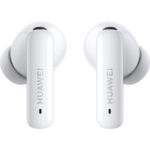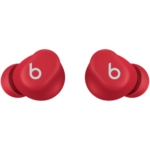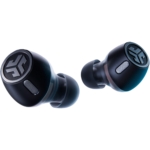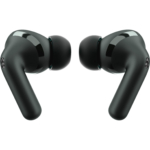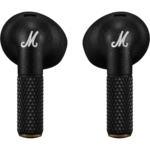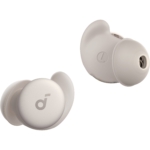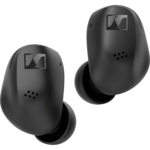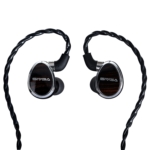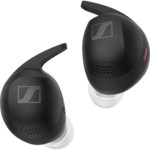SoundPEATS gives their two Air models a new version number. Although the supported Bluetooth standard has been upgraded from version 5.2 to 5.3, this is more like a step backwards sonically, as the emphasis of the sound is now more on the mids and trebles.
- Customizable hearing profile
- 10-band equalizer
- Slim design
- aptX Lossless (Air4) & LDAC (Air4 Lite)
- Somewhat mid-heavy sound
- Mediocre speech intelligibility during phone calls
The speed with which the Shenzhen-based company SoundPEATS keeps launching new in-ear headphones is truly breath-taking. The battery of our Air3 was only just empty when the fourth edition of these inexpensive earbuds arrived at our editorial office. The Air4 comes in a regular and a Lite version, and as they only differ slightly to look at – despite technical differences – they are so similar in their concept that we decided to test them together.
The technology of the SoundPEATS Air4 and Air4 Lite
Common to both sets of earpieces is the use of dynamic 13-millimetre drivers, giving the Air4s a frequency response of 20 Hz to 20 kHz and even the Air4 Lite – according to the datasheet – make it up to 40 kHz.
Three microphones per earpiece are said to provide good call quality in the case of the Air4 Lite and effective noise cancelling on the Air4.
In the SoundPEATS Air4, the “processor intelligence” comes from a Qualcomm QCC3071 chip, which is able to communicate with the playback device via the codecs aptX Lossless, AAC and SBC. AptX Lossless and thus the lossless audio transmission (24 bit/96 kHz) between the external player and these earphones is part of (in addition to 3D audio, ultra-low latency and stable connection) “Snapdragon Sound” technology from Qualcomm, which they see as an Android alternative to Apple’s “Spatial Audio” and it is already built into newer products from Samsung, Motorola or Sony, for example.
The “smaller” SoundPEATS Air4 Lite lack this Qualcomm chipset and aptX, but they are LDAC-capable (a high-resolution codec from Sony [24 bit and 96 kHz]).
Once again, the certification of the two sets of earpieces is the same; they are both covered by IPX4 (protection against splashes of water).
How do the SoundPEATS Air4 and Air4 Lite look?
Compared to the previous model, which is (still) available in either white or black, version 4 is currently only available in black. As a decorative colour for the sensor surface and the speaker grille (which is not visible when wearing the headphones anyway), a touch of red gold has now been added (in matt on the Air4, in gloss on the Lite version).
Personally, I preferred the plain colour scheme. However, the colour accent is not so conspicuous that it might affect your buying decision. Both Earbud models share the same case format, and indeed, both sets of earphones slide easily into the case of either version and are held there magnetically. The only difference is that the surface of the charging case has a matte finish with the Air4 and a high-gloss finish with the Air4 Lite.
These cases receive power via a USB-C socket on the underside (a 26-centimetre USB-A to C cable is included). The average runtime for the Air4 is a respectable 6.5 hours (Air4 Lite: 7 hours), and the charging case has enough power reserves for around four full charges. An LED underneath the case flap provides information about the charging status and the remaining battery reserve.
SoundPEATS Air4 and Air4 Lite handling
Basically, these are “semi-in-ears” or “earbuds” similar in style to the Apple AirPods. Accordingly, these earbuds do not require ear moulds and are simply hung in the ear cavity between the tragus and antitragus, which means they are hardly noticeable, with each earbud weighing just four grams. The Air4s are correspondingly comfortable to wear. It was only after a longer period of listening that the hard plastic began to press somewhat uncomfortably against the tragus (the small flap in front of the ear opening). Of course, the absence of ear moulds inevitably increases the emission – i.e. the audibility – of ambient noise. This level of emission also torpedoes the Air4’s active noise cancelling capabilities (the Lite version comes without ANC). Although SoundPEATS state the strength of the ANC as up to 35 decibels, the audible suppression of ambient noise was far below that – to be more precise: at the borderline of inaudibility.
Pressing the integrated button inside the case puts the earphones into Bluetooth pairing mode, whereupon they will identify themselves to the Bluetooth player and immediately become available for audio and telephone functions (when used with a mobile phone) after confirmation. If the headphones are paired with another Bluetooth player after a connection has been established, both devices remain connected. The last player to contact the SoundPEATS will always “win” the upper hand.
The SoundPEATS app, which is now pretty stable, is also used with the Air4s, and here you can make individual sound adjustments via a 10-band equaliser (+/- 6 dB per band). In addition, there is a listening test available, and this tests your hearing ability and generates an optimised equaliser curve from it. You should certainly run through this listening test because the equalised curve makes a truly amazing sound improvement – especially if you suffer from a hearing deficit in a particular frequency range.
The operation of these in-ears via the contact surfaces on the sides works with reasonable accuracy, so that operating errors only happen occasionally if you have learned the necessary commands by heart from tapping and holding down. If you want to avoid any annoying false triggers, you can conveniently deactivate the touch function via the app.
However, making phone calls with the Air4s is rather tedious – especially on the receiving end. This is because, in addition to mumbled sound, the headphones tend to “swallow” word beginnings and endings, which can be especially problematic for business people who need to make million-dollar deals on their mobile phones. But even for personal use, ordering an “izza without mea” can be misunderstood if you’re a vegetarian and want your Italian slices without prosciutto.
How do the SoundPEATS Air4 and Air4 Lite sound?
In general, the SoundPEATS Air4 had a full-spectrum frequency response that didn’t reveal any major gaps. The Air4 tended to pay a little more attention to the treble than the bass – but you can counteract this quite well with the equaliser, depending on your personal preferences. For my taste, the mids were a little over-present. I had to reduce the midrange by six decibels at 800 Hz and by another two decibels at 1 kHz before something like linearity was achieved. However, each activated EQ band means a change in phase coherence. So, it should be an elementary goal of every headphone design to sound balanced even without equalisation.
Another thing that I didn’t really like about the Air4 was the immersion and dynamics. In principle, semi-in-ears, or earbuds, don’t have the directness and impulsiveness that full-fledged in-ears have. Nevertheless, the latest earbud design managed to conjure up a certain impulsiveness, as the previous model Air3 had already demonstrated. In a direct comparison, it became apparent that the sound tube on the predecessor was a little narrower and had a slightly different angle to the ear. This may be the reason why the Air4s sounded a little more restrained.
As a result, you’re much more likely to notice “those objects playing music in your ears” with the Air4s than you were with the Air3. This is even less so, of course, with the fabulous Capsule3 Pro from the same company, which often makes you forget you’re wearing in-ears, and give you an impressive dynamic range. To be fair, though, these are a classic in-ear model.
Conclusion
The frequency of these new in-ear models from SoundPEATS remains high. However, the current versions of the Air4 range also show that an extremely rapid roll-out rate without substantial work on development does not always result in progress. After all, LDAC or Snapdragon – chips and features alone do not make for a good sound; the tuning of the diaphragm, the sound tube and the cabinet are much more important.
This doesn’t mean that the Air4 models are bad, but in terms of sound, they are a step backwards compared to their predecessors, which are still available. In both Air4 models, the somewhat boomy mid-range stands out sonically, and in the case of the Air4, the Active Noise Cancelling (ANC) does nowhere near as much as on other products in this highly competitive price segment.
Technical specifications
- Ear couplingEarbuds
- Typeclosed
- Transducer principledynamic
- Frequency response (headphones)20 - 40.000 Hz
- Weight without cableeach 4 g
- Cable length26 cm
Special features
- BT codecs: SBC, AAC, LDAC (Air4 Lite), aptX Lossless (Air4)
- BT version: 5.3









